The First Physically Mapped Human Gene
Curtain open
In 1983, James Gusella discovered the genetic basis for Huntington's Disease. Called the Huntingtin (HTT), it was "the first disease-associated gene to be molecularly mapped to a human chromosome."[1]
Readers of my posts might wonder at that relatively late date. 1983? Genes were being discovered and mapped in peas and flies and worms long before that. What took humans so long?
Well, you see, it takes two to tango. I've talked extensively about the molecular side of things in prior posts — the molecular tango partner. But you also need a phenotype — the macroscopically visible product of the gene — and humans are not as easy as yeast and Drosophila to partner up and force to have experimental children for the sake of clarifying phenotypes. To put it more scientifically, "informative crosses [were] lacking"[2]. Population samples were also too small to be statistically significant. And lastly, the human genome is enormous compared to these model lab organisms.

This is not what I mean by "model lab".
Source: Maxpixel FreeGreatPicture
In other words, the science was up to the task — molecularly speaking. But whereas it was relatively easy to cross flies and get phenotypes such as curly wings and then ask what genes were responsible for them, it wasn't as easy to isolate a trait of interest in humans. And without a clear trait of interest, you can't go on a gene hunt for that trait.
So how did they do it?
RFL(P?)
It's uncertain whether rolling on the floor laughing was in existence in the 80s, but restriction fragment length polymorphisms (RFLPs) certainly were. These are neutral DNA polymorphisms (differences in DNA letters). Neutral because their being different doesn't matter. They are silent variations, if you will, between individuals, that are not associated with any macroscopically observable differences in the individual.
They're important because this is how the problem of "no clear phenotypes" was solved. Like Sturtevant did in his famous all-nighter, you could build a linkage map (also called a chromosome map) in flies, because you had clear visible traits like curly wings and red eyes — and in some cases unmissably visible like feet in place of a fly's antennae (called, aptly, antennapedia).
Biologist David Botstein's idea was, instead of using phenotypes to build linkage maps, to use these polymorphisms instead.[3] All you needed really was some kind of marker or road sign, and these polymorphisms served perfectly.
Mind you, another method of gene-finding, namely doing complementation tests, was out of the question for Huntington's disease, because complementation relies on dominant genes "rescuing" recessive genes, and Huntington's was dominant, so nothing could rescue it.
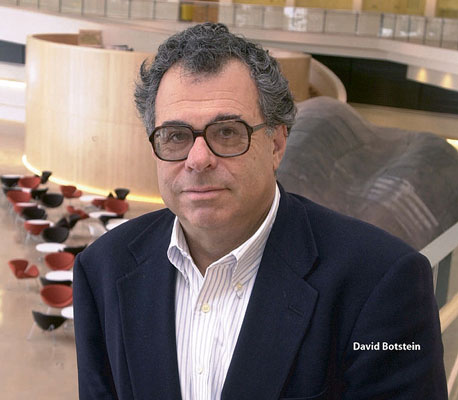
I didn't put that name there. The man wears his name on his sleeve.
Source: Wikimedia Commons contributors
So the first hurdle being thusly overcome by Botstein, it was up to other long-legged humans (partly Gusella himself) to jump over the hurdle of small population size. This was solved by finding two Venezuelan villages in which the prevalence of the disease was unusually high: more than 18,000 people, to be inexact, most descended from a single family.[4] Heading the study was Gusella's paper's second named author Nancy Wexler, who continued the research for 20 years, until political events forced her to discontinue this remarkably longitudinal study.[7]
Last hurdle
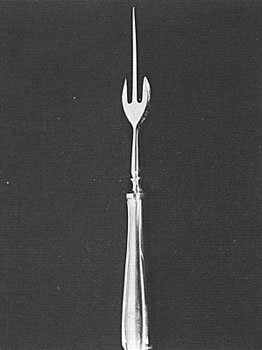
Fork needs to be taught some manners.
Source: purdue.edu
So now James Gusella inherits a 3-pronged problem with 2 prongs filed off. One prong remains: the human genome is vast. It's marked alright, like a ruler, due to Botstein's work. But it's still vast: how is Gusella going to find the marker that is nearest the gene responsible for Huntington's?
Remember, there's no human genome map yet, the Human Genome Project hasn't yet begun.
So Gusella had this bright idea: he'll take pieces of DNA, see if they contained a Botstein polymorphism, and then check to see if it was linked to Huntington's. Yes, that's the opposite of a bright idea. It's the absence of an idea. Gusella basically decided to brute-force the thing.
Given that there's around 3 million Botstein markers in the human DNA, Gusella was looking at a long night.
So of course he found the site he was looking for at his 12th try.
Wonder if he ever tried playing the Lotto.
Hunting the Huntingtin gene: Gusella's Lucky Number 12
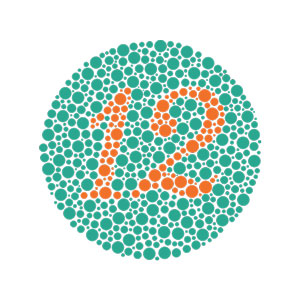
Lucky number. Unless of course you can't see it, in which case that's unlucky, boy this joke went south real fast, I apologize.
Source: Wikimedia Commons contributors
On his 12th trial, Gusella got the link. Lucky right?
But that wasn't enough. He's still not on the spot itself, just near it. A 1% recombination would mean he's a million bases (letters) away from the gene itself. I'm not pulling that number our of a magic hat. Later, when the same method was being used to discover the gene for cystic fibrosis, they got within 1.5 million letters:
The CF gene was thought to be inside this region [...] But between these markers lay 1.5 centimorgans (map units) of DNA, a vast uncharted terrain of 1.5 million bases.[2]
The Huntington gene turned out to be 4Mb (4 million bases) away from the Lucky Number 12 locus.[7]
So what could Gusella do in this case?
He could keep trying the random method, that's one option. But the probabilities were against him. He must proceed from where he was, somehow do it in a directed manner this time.
To the rescue comes a technique called physical mapping. What you do basically is you take the DNA pieces you've made via cloning, you radioactively label them, then you swish them around (I'm oversimplifying) in a container containing your fragment that is linked to the Huntington's gene, and hopefully the fragments that overlap will stick to each other. And now you can do the same with the longer fragment, and hopefully get closer to the gene. I say hopefully, because you could also get farther away from it. But eventually, by testing linkage, you'll know which of the two directions is the correct one. And you will gradually "walk" toward your gene of interest, in what's called, unsurprisingly, chromosome walking.
Is that the end? No. Even at 0% recombination, it doesn't mean that whole region of DNA is the gene responsible for the disease in question. Your children may inherit your diseases along with your property, but that doesn't mean the two are connected.
So what you do is you keep testing people, populations, and gradually arrive at what is most probably the sequence of letters that causes the disease you are looking for.
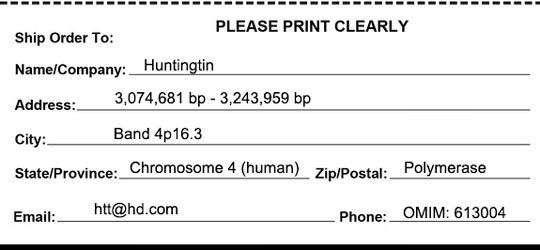
Source: flickr, modified
In the case of Huntington's, a series of repeated letters CAG were found to be the culprit. These are the Huntingtin gene. Between 7 and 35 of these repeats are normal and will leave you unaffected, 36 to 40 CAG repeats may or may not give you the disease, and more than 40 repeats means you are royally CAG-rewed.[6]
Curtain close
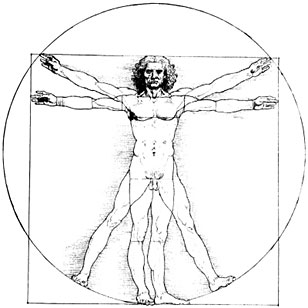
Most call him Vitruvian Man. I call him Jumping Jack.
Source: Wikimedia Commons contributors
Imagine every researcher having to do what Gusella did with each individual gene of interest. That's what the Human Genome Project was meant to render unnecessary. A common DNA library open to all scientists for free, a complete map of the human genome, so that the scientists didn't each have to spend years upon years doing the same painstaking work.
After 10 years of chromosome walking (not so lucky now, eh?), in 1983 Gusella published his work on the HD gene, and in 1984 the idea of the Human Genome Project was picked up by the US government. The project was launched in 1990 and in 2000 the whole human genome was sequenced. 10 years for a single gene. 10 years for the whole genome. That's what collaboration will do for you.
REFERENCES
1. Chial, H. (2008) Huntington's disease: The discovery of the Huntingtin gene. Nature Education 1(1):71 https://www.nature.com/scitable/topicpage/huntington-s-disease-the-discovery-of-the-851
2. Griffiths AJF, Miller JH, Suzuki DT, et al. An Introduction to Genetic Analysis. 7th edition. New York: W. H. Freeman; 2000. Structural genomics. Available from: https://www.ncbi.nlm.nih.gov/books/NBK21841/
3. Botstein D, White RL, Skolnick M, Davis RW. Construction of a genetic linkage map in man using restriction fragment length polymorphisms. American Journal of Human Genetics. 1980;32(3):314-331. https://www.ncbi.nlm.nih.gov/pmc/articles/PMC1686077/
4. Gusella, J. F., et al. A polymorphic DNA marker genetically linked to Huntington's disease. Nature volume 306, pages 234–238 (17 November 1983) doi:10.1038/306234a0 https://www.nature.com/articles/306234a0
5. Wikipedia contributors, "Primer walking," Wikipedia, The Free Encyclopedia, https://en.wikipedia.org/w/index.php?title=Primer_walking&oldid=823994568 (accessed February 16, 2018).
6. Wikipedia contributors, "Huntingtin," Wikipedia, The Free Encyclopedia, https://en.wikipedia.org/w/index.php?title=Huntingtin&oldid=809414625 (accessed February 16, 2018).
7. Bates, G. P. History of genetic disease: The molecular genetics of Huntington disease — a history. Nature Reviews Genetics 6, 766-773 (2005) doi:10.1038/nrg1686. https://www.nature.com/scitable/content/History-of-genetic-disease-The-molecular-genetics-15297
Earlier Introduction to Biology episodes:
14: Sequencing DNA using Gel Electrophoresis
13: Cutting, Pasting, Cloning, and GMOs
12: How a Boy From an Indian Village Broke the Code of Life and Won the Nobel Prize
11: The Most Beautiful Experiment In Biology
10: The Great GATC-by: The Most Famous Science Paper of the 20th Century
9: The Great Kitchen Blender Experiments: How DNA was proved to be the seat of heredity
8: Finding, Counting, and Ordering Genes Using Incredibly Sophisticated Biomolecular Megatechnology
7: Christmas Disease — Yes, it's real, 100% scientifically proven!
6: The Most Famous All-Nighter in the History of Genetics
5: Mendel's Lucky Number Seven — The law of genetics that almost wasn't
4: How Cells Use Logic To Do The Impossible
3 : Armchair Science — The Discovery of Proteins' Secondary Structure
2 : How Cell Membranes Form Spontaneously
1 : Eduard Buchner: The Man Who Killed Vitalism
steemSTEM is the go-to place for science on Steemit. Check it out at @steemstem or browse the #steemSTEM tag or chat live at steemit.chat or discord
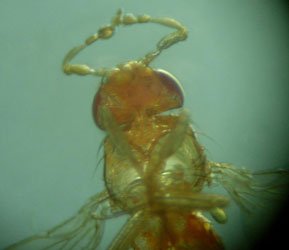
The way you described the historical background of the findings was very interesting. You definitely got me as a new follower. I really liked how you linked it to the Human Genome Project which in my opinion was the most profound undertaking of the past 20 years. Looking back at that time when only Sanger sequencing was available, it is almost unimaginable how much effort and time was required to achieve this task. Furthermore, the much greater task was then to put the small pieces of DNA together, as Sanger sequencing usually yielded fragments of only up to 1000 base pairs. Now imagine you have a puzzle with 3 billion pieces and you have to find the exact pieces that fit - quite a tedious task. Today, with the next generation sequencing methods and with the complete assembly of a human genome it has become quite "simple" to analyse the complete genome of thousands of people in a short time. Regarding the costs, it is almost incredible that the sequencing of the first human genome cost about 3 billion dollars. Today this has been reduced to only 1000 dollars (it becomes cheaper every day), which makes the process of genome analysis much more affordable and accessible for the broader mass.
Thank you for your intriguing post!
Thank you for reading and for the comment!
Hopefully as sequencing gets increasingly cheaper we'll all be able to do it. Then all that data will help to more accurately determine increased risks we may have for certain diseases. Ideally we'll be able (and willing) to input all our habits in some open source manner, like everything we eat, exercise, etc., so that people who share similar DNA sites with us will know what works and what doesn't health-wise.
I hope you do a post on the US-led human genome project next. Watson, of Watson and Crick, was the head of government genomics project. 7 years into the project with billions in funding producing little in the way of results, Craig Venter, a lower ranking scientist, approaches Watson with a novel idea. Use cutting enzymes, replicate the pieces, and have supercomputers analyze. (Something along those lines of automating most of the technical minutiae) Watson calls him a talentless monkey and throws him out of his office. Venter fuming, leaves the genomics project and founds Celera to compete with the government initiative.
Celera promises patents on DNA/genes mapped and raises enough capital to compete with the government initiative and quickly outpaces them. By this time Watson is out of the picture, and the government adopts Venter's method, barely beating him to completing the human genomic sequence first. Alas! The germ of patenting human gene and profiting from DNA has already been set loose upon the ravenous mercantile parasites, all because Watson could not see beyond his oversized ego.
I remember only the superficialities of Craig Venter's involvement. The competition did push the government to complete the project sooner, that much I remember.
The Human Genome Project will come up soon, maybe even in the next post.
Your writing is just perfect. I am glad that @trumpman appointed you to me :)
Steem on.
( I had to use dictionary in more than one occasion. That says lots about your writing level. Kudos)
I didn't know I was appointed to anyone! What are the perks? Can I charge you for my lunches? :P
Thanks for reading and for the very nice words )
My vote is barely a souvlaki haha if you ever need or you know someone that legit needs some help let me know. Thanks for writing
Έλιωσα με τις φωτογραφίες 😂😂🤣🤣
Loved the post. Love making science digestible to the masses, and I hate myself for saying it, but if you dumbed it down a little more, more people could understand it.
I am working hard at de-educating myself! :P
But you're right, accessibility is important and I'm always working on it.
Being A SteemStem Member
Nice post! I was doing RFLP back in the 80's. We were working on satellite DNA when it was commonly called "junk DNA."
What an incredible article, this is why i love steemstem
Sequencing the genome project was very popular project during the first years of millennium. After wards, feel that bioinformatics got the attention from many different major disciplines. Currently, you can find at least one bioinformatics researcher almost in Computer Engineering departments.
Thanks to your differint post...thank you to know me thin scince..